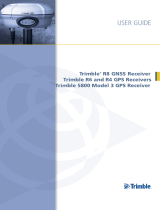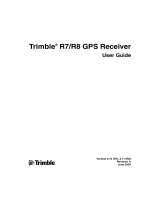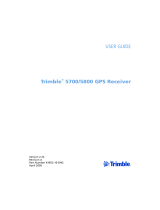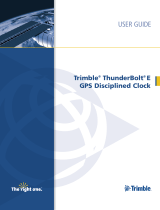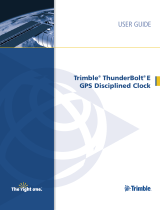Page is loading ...

Trimble R580
GNSS RECEIVER
The front panel contains the Power button, which also shows the status of the receiver via LED. The
Power button controls the receiver’s power on or o functions. The Status LED shows the status of the
power and radio reception.
QUICK START GUIDE

The lower housing contains:
1TNC radio antenna connector. Use the TNC connection for the antenna for the optional 450 MHZ
UHF radio.
2removable battery compartment.
3micro USB port.
4⅝-11 threaded insert.
2

Power the receiver on/o
Power on the receiver by pressing and releasing the Power button on the front panel.
Power o the receiver by pressing and holding the power button until the LED turns o, approximately 2
seconds.
Button function
The receiver has only one button, the Power button. Press the Power button to turn on or turn o the
receiver, and to perform other functions, as described below:
To... Press the button
for...
LED behavior Notes
turn o the receiver more than 2 seconds
but less than 15
seconds
Green: O after 2
seconds.
Yellow: On after 2
seconds and remains
On until shutdown
complete.
clear the ephemeris le
and reset the receiver
to the factory defaults
more than 15 seconds
but less than 30
seconds
Green: O after 2
seconds.
Yellow: On after 2
seconds and then Slow
Flash after 15 seconds
to indicate 15 seconds
has elapsed.
If the button is released,
the 15 seconds data
is cleared. The yellow
ash continues until the
operation is complete.
The receiver then
enters the reboot cycle.
NOTE - The term “press” means to press the button and release it immediately. The term “hold”
means to press the button and hold it down for the given time.
3

Activate warranties, install options, install radio frequencies, and
update rmware
1. Install Trimble® Installation Manager. Go to trimble.com/installationmanager.
2. Connect the receiver to your computer using the lemo to USB accessory cable (P/N xxxxx).
3. Start Trimble Installation Manager.
4. Select the Receiver tab and click Connect.
Charge the battery
Charge the battery (P/N 192670-25) in the Trimble dual slot battery
charger (P/N 109000).
Insert the battery
1. Open the receiver battery door by pressing down on the battery door latch and allowing the door to
swing open.
2. Slide the battery (P/N 192670-25) into the battery tray with the metal contacts facing up and to the
rear of the battery compartment.
3. Close and secure the battery door.
4

Connect the radio antenna
Connect the radio antenna— P/N 44085-60 (450 MHz)—to the TNC connector on the underside of the
receiver. Do not overtighten.
Using the web interface
1. Power on the receiver and wait for the Wi-Fi LED to start ashing.
2. Search for available Wi-Fi networks on your smartphone or computer. Select Trimble GNSS xxxx
(xxxx represents the last four digits of the receiver’s serial number).
The default network password is: abcdeabcde
3. On your smartphone or computer:
a. Open a web browser and enter the IP address: http://192.168.142.1
b. Log into the web interface. The default login details are:
User name: admin
Password: password
4. The rst time you connect to the web interface, you are prompted to change the default login
credentials.
Alternatively you can access the receiver’s web interface using the cable P/N xxxxx, and IP address
192.168.144.1.
5

Safety information
Before you use your Trimble product, make sure that you have read and understood all safety requirements.
WARNING – This alert warns of a potential hazard which, if not avoided, could result in severe injury or even
death.
CAUTION – This alert warns of a potential hazard or unsafe practice that could result in minor injury or property
damage or irretrievable data loss.
NOTE – An absence of specic alerts does not mean that there are no safety risks involved.
Use and care
This product is designed to withstand the rough treatment and tough environment that typically occurs in construction
applications. However, the receiver is a high-precision electronic instrument and should be treated with reasonable care.
CAUTION – Operating or storing the receiver outside the specied temperature range can damage it.
Regulations and safety
Some receiver models with base station capability contain an internal radio-modem for transmission or can transmit
through an external data communications radio. Regulations regarding the use of the 403 MHz to 473 MHz radio-
modems vary greatly from country to country. In some countries, the unit can be used without obtaining an end-user
licence. Other countries require end-user licensing. For licensing information, consult your local Trimble dealer.
NOTE – The R580 GNSS device can not transmit but it can receive RF signal in the 403 MHz to 473 MHz frequency
range.
All Trimble receiver models described in this documentation are capable of transmitting data through Bluetooth and
Wi-Fi 802.11 b/g/n wireless technology.
Bluetooth and Wi-Fi 802.11 b/g/n wireless technology radio-modems operate in licence-free bands.
Before operating a Trimble receiver, determine if authorisation or a licence to operate the unit is required in your country.
It is the responsibility of the end user to obtain an operator's permit or licence for the receiver for the location or country
of use.
6

Type approval
Type approval, or acceptance, covers technical parameters of the equipment related to emissions that can cause
interference. Type approval is granted to the manufacturer of the transmission equipment, independent from the
operation or licensing of the units. Some countries have unique technical requirements for operation in particular
radio-modem frequency bands. To comply with those requirements, Trimble may have modied your equipment to be
granted type approval.
Unauthorised modication of the units voids the type approval, the warranty, and the operational licence of the
equipment.
Exposure to radio frequency radiation
R580 (with internal 450 MHz radio operating only in receiver mode, not in transmitter mode).
For 450 MHz radio
Safety. Exposure to RF energy is an important safety consideration. The FCC has adopted a safety standard for human
exposure to radio frequency electromagnetic energy emitted by FCC regulated equipment as a result of its actions
in General Docket 79-114 on March 13, 1986 and KDB447498, RF Exposure Procedures and Equipment Authorisation
Policies For Mobile and Portable Devices.
Proper use of this radio modem results in exposure below government limits. The following precautions are
recommended:
• DO NOT co-locate the radio antenna with any other transmitting antenna.
• DO NOT operate the transmitter unless all RF connectors are secure and any open connectors are properly
terminated.
• DO NOT operate the equipment near electrical blasting caps or in an explosive atmosphere.
• All equipment must be properly grounded according to Trimble installation instructions for safe operation.
• All equipment should be serviced only by a qualied technician.
For licence-free Bluetooth and Wi-Fi 802.11 b/g/n
CAUTION – For your own safety, always observe these precautions:
- For Bluetooth and Wi-Fi 802.11 b/g/n - Always maintain a minimum separation distance of 20 cm (7.9 inches)
between yourself and the radiating antenna.
WARNING – The GNSS and its cabling should be installed in accordance with all national and local electrical
codes, regulations, and practices. The cabling should be installed where they will not become energised as a result
of falling nearby power lines, nor be mounted where they are subjected to over-voltage transients, particularly
lightning. Such installations require additional protective means that are detailed in national and local electrical
codes.
Trimble receiver internal radios have been designed to operate with the antennas listed below. Antennas not
included in this list are strictly prohibited for use with this device. The required antenna impedance is 50 ohms.
To reduce potential radio interference to other users, the antenna type and its gain should be an approved Trimble
antenna, so that the equivalent isotropically radiated power (e.i.r.p.) is not more than that permitted for successful
communication.
7

Regulatory information
For full legal and regulatory information, please go to https://receiverhelp.trimble.com/r580-gnss.
USA
FCC Compliance Statement
Model Numbers: R580
FCC Class B - Notice to Users. This device complies
with part 15 of the FCC rules.
RESPONSIBLE PARTY:
Trimble Inc.
10368 Westmoor Drive
Westminster CO 80021
USA
trimble.com/Corporate/Contacts.aspx
This device complies with Part 15 of the FCC Rules. Operation is
subject to the following two conditions: (1) this device may not
cause harmful interference, and (2) this device must accept any
interference received, including interference that may cause
undesired operation. Changes or modications made to this
equipment not expressly approved by Trimble Inc may void the
FCC authorisation to operate this equipment.
The UHF (403 MHz to 473 MHz) receiver was tested with a
monopole antenna (400 MHz to 512 MHz,-2dBi typical peak gain,
TPN44085-60). The connector type is TNC.
Canada
This device contains licence-exempt transmitter(s)/receiver(s)
that comply with Innovation, Science and Economic Development
Canada’s licence-exempt RSS(s). Operation is subject to the
following two conditions:
• This device may not cause interference.
• This device must accept any interference, including
interference that may cause undesired operation of the device.
L’émetteur/récepteur exempt de licence contenu dans le présent
appareil est conforme aux CNR d’Innovation, Sciences et
Développement économique Canada applicables aux appareils
radio exempts de licence. L’exploitation est autorisée aux deux
conditions suivantes :
(1) l’appareil ne doit pas produire de brouillage;
(2) l’appareil doit accepter tout brouillage radioélectrique subi,
même si le brouillage est susceptible d’en compromettre le
fonctionnement.
Under Industry Canada regulations, this radio transmitter may
only operate using an antenna of a type and maximum (or lesser)
gain approved for the transmitter by Industry Canada. To reduce
potential radio interference to other users, the antenna type and
its gain should be chosen so that the equivalent isotropically
radiated power (EIRP) is not more than that required for
successful communication.
Conformément à la réglementation d’Industrie Canada, le présent
émetteur radio peut fonctionner avec une antenne d’un type et
d’un gain maximal (ou inférieur) approuvé pour l’émetteur par
Industrie Canada. Dans le but de réduire les risques de brouillage
radioélectrique à l’intention des autres utilisateurs, il faut choisir
le type d’antenne et son gain de sorte que la puissance isotrope
rayonnée équivalente (PIRE) ne dépasse pas l’intensité nécessaire
à l’établissement d’une communication satisfaisante.
This Class B digital apparatus complies with Canadian ICES-003.
Cet appareil numérique de la classe B est conforme à la norme
NMB-003 du Canada.
This apparatus complies with Canadian RSS-GEN, RS-102,
RSS-247.
Cet appareil est conforme à la norme CNR-GEN, CNR-102,
CNR-247 du Canada.
The UHF (403 MHz to 473 MHz) receiver was tested with a
monopole antenna (400 MHz to 512 MHz,-2dBi typical peak gain,
TPN44085-60). The connector type is TNC.
Le récepteur UHF (403 MHz à 473 MHz) a été testé avec une
antenne monopôle (400 MHz à 512 MHz, gain de crête typique de
-2 dBi, TPN44085-60). Le type de connecteur est TNC
United Kingdom
Hereby, Trimble Inc., declares that the R580
GNSS receiver complies with the following UK
legislations:
• S.I. 2016 No. 1101, Low Voltage, RF Exposure
• S.I. 2016 No. 1091, EMI/EMC
• S.I. 2017 No. 1206, Radio Equipment
8

Australia and New Zealand
This product conforms with the regulatory
requirements of the Australian Communications and
Media Authority (ACMA) Radiocommunications Act.
Europe
Hereby, Trimble Inc., declares that the R580 GNSS
receiver complies with the following directives:
• RED 2014/53/EU
• RoHS Directive 2011/65/EU
• RoHS Directive 2015/863/EU
• WEEE Directive 2012/19/EU
CE marking
The products covered by this guide may be operated in all EU
member countries (BE, BG, CZ, DK, DE, EE, IE, EL, ES, FR, HR, IT,
CY, LV, LT, LU, HU, MT, NL, AT, PL, PT, RO, SI, SK, FI, SE), Norway
and Switzerland. Products been tested and found to comply
with the requirements for a Radio Equipment device pursuant
to European Council Directive 2014/53/EU on EMC, thereby
satisfying the requirements for CE Marking and sale within the
European Economic Area (EEA). Contains a Bluetooth radio
module. These requirements are designed to provide reasonable
protection against harmful interference when the equipment is
operated in a residential or commercial environment.
Recycling
For product recycling instructions and more
information, go to www.trimble.com/en/our-
commitment/responsible-business/corporate-
compliance/environmental-compliance.
9

Made for
• iPhone 13
• iPhone 13 Pro
• iPhone 13 Pro Max
• iPad (9th generation)
• iPad Pro 12.9-in. (5th generation)
• iPad Pro 11-in. (3rd generation)
Use of the Made for Apple badge means that an accessory has been designed
to connect specically to the Apple product(s) identied in the badge and has
been certied by the developer to meet Apple performance standards. Apple is
not responsible for the operation of this device or its compliance with safety and
regulatory standards.
iPad and iPhone are trademarks of Apple Inc., registered in the U.S. and other
countries.
Google, Google Play, and other marks are trademarks of Google LLC.
Trimble Inc.
10368 Westmoor Drive
Westminster CO 80021
USA
© 2023, Trimble Inc. All rights reserved. Trimble, and the Globe & Triangle logo are
trademarks of Trimble, registered in the United States and in other countries. All other
trademarks are the property of their respective owners. Rev B (06/23).
trimble.com
/



